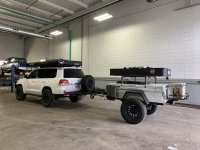wADVr
Adventurer
Hello,
I’d like your feedback on ideal width for both the tub/body of the trailer and the track width. How do these small narrow trailers tow behind wide late model Jeeps, full size rigs, Toyotas etc?
Narrow body and narrow track width will work well in our local PNW tight trails but I’m thinking that’s about it. Rutted non technical trails and forest roads make me start thinking how important same or close track width to the tow vehicle would be much more stable with less opportunity for the trailer to get crossed up and flip as I seem to see quite often with these narrow M416 style trailers. then I think of driving 10 hours on the freeway at 70mph where these surfaces are also rutted or snow slush covered and I see that this would be somewhat sketchy or at least exhausting.
For those wondering what I’m up to…. I recently acquired a M100 trailer tub missing the floor (so all four sides only) that I am considering using to build up a new frame/suspension and it would be relatively easy to cut and add material to widen the trailer for a desired width. I was considering widening the tub 8” to be 56”(including round stock rails) and also between 62-65” track width to match my JK(65”) But am I ruining the appeal to this trailer by adding this width and really it’s not a bid deal so just leave it alone. That is really what I am trying to learn from this thread.
The M100 is 3” narrower at the bottom(38 vs 41”) and 4” narrower at the top (48” vs 52”) for a M416 So this adds a little to my concern. This compared to my M101 it is almost inconceivable that it would work well towed behind a JK, that said it is also hard to think one would tow the larger trailer as well.. however I have been quite pleased and have towed it across the state and up difficult trails to some pretty spectacular alpine lakes. Other than super tight trails this works great with the exception of weight. My JK pulls it fine and pretty much can’t tell it’s back there but over a long freeway drive up and down mountain passes in the summer heat it adds up and is a little taxing both on the wallet and is somewhat draining on the mental/physical side. I’m thinking going light weight and more capable might be the way and can shed 1000 or more pounds going the M100/416 route.
thank you for any insight!
I’d like your feedback on ideal width for both the tub/body of the trailer and the track width. How do these small narrow trailers tow behind wide late model Jeeps, full size rigs, Toyotas etc?
Narrow body and narrow track width will work well in our local PNW tight trails but I’m thinking that’s about it. Rutted non technical trails and forest roads make me start thinking how important same or close track width to the tow vehicle would be much more stable with less opportunity for the trailer to get crossed up and flip as I seem to see quite often with these narrow M416 style trailers. then I think of driving 10 hours on the freeway at 70mph where these surfaces are also rutted or snow slush covered and I see that this would be somewhat sketchy or at least exhausting.
For those wondering what I’m up to…. I recently acquired a M100 trailer tub missing the floor (so all four sides only) that I am considering using to build up a new frame/suspension and it would be relatively easy to cut and add material to widen the trailer for a desired width. I was considering widening the tub 8” to be 56”(including round stock rails) and also between 62-65” track width to match my JK(65”) But am I ruining the appeal to this trailer by adding this width and really it’s not a bid deal so just leave it alone. That is really what I am trying to learn from this thread.
The M100 is 3” narrower at the bottom(38 vs 41”) and 4” narrower at the top (48” vs 52”) for a M416 So this adds a little to my concern. This compared to my M101 it is almost inconceivable that it would work well towed behind a JK, that said it is also hard to think one would tow the larger trailer as well.. however I have been quite pleased and have towed it across the state and up difficult trails to some pretty spectacular alpine lakes. Other than super tight trails this works great with the exception of weight. My JK pulls it fine and pretty much can’t tell it’s back there but over a long freeway drive up and down mountain passes in the summer heat it adds up and is a little taxing both on the wallet and is somewhat draining on the mental/physical side. I’m thinking going light weight and more capable might be the way and can shed 1000 or more pounds going the M100/416 route.
thank you for any insight!






